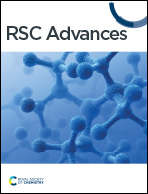Structure searches and superconductor discovery in XB2 (X = Sc, Ti, V, Cr, and Tc)†
Abstract
With extensive structure searches for XB2 (X = Sc, Ti, V, Cr, and Tc) under pressures up to 100 GPa, we uncovered that the crystal structures of these compounds with the lowest enthalpy have the same space group (P6/mmm) as MgB2 at ambient pressure. Among them, ScB2, TiB2 and VB2 are dynamically stable at ambient pressure, but they do not superconduct. CrB2 becomes dynamically stable at 108 GPa and shows superconductivity with a transition temperature (Tc) of 26.0 K. TcB2 is not dynamically stable until 9 GPa. At 20 GPa, it has a Tc of 23.5 K. Further calculations indicate that CrB2 and TcB2 are also thermodynamically stable, suggesting that it is highly likely that they can be synthesized successfully in the laboratory. We found that transition metal atoms (Cr/Tc) dominate soft phonon vibrations and make significant contributions to the electron–phonon coupling (EPC) and superconductivity in CrB2/TcB2, which is in strong contrast to the case of MgB2, where high-frequency B vibrations dominate the EPC and superconductivity. Our work enriches the understanding of superconductivity in transition metal borides.



 Please wait while we load your content...
Please wait while we load your content...